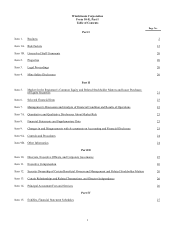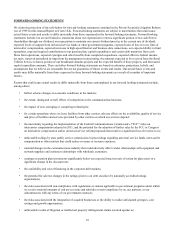Windstream 2012 Annual Report Download - page 64
Download and view the complete annual report
Please find page 64 of the 2012 Windstream annual report below. You can navigate through the pages in the report by either clicking on the pages listed below, or by using the keyword search tool below to find specific information within the annual report.
Windstream Corporation
Form 10-K, Part 1
2
Item 1. Business
THE COMPANY
Unless the context requires otherwise, the use of the terms "Windstream," "we," "us" and "our" in this Annual Report on Form
10-K refers to Windstream Corporation and its consolidated subsidiaries.
OVERVIEW
Windstream's vision is to become the premier enterprise communications and services provider in the United States while
maintaining our strong, stable consumer business. Windstream provides advanced communications and technology solutions,
including managed services and cloud computing, to businesses nationwide. In addition to business services, we offer
broadband, voice and video services to consumers in primarily rural markets. We have operations in 48 states and the District of
Columbia, a local and long-haul fiber network spanning approximately 115,000 miles, a robust business sales division and 23
data centers.
Strategy
Our strategy is to maximize growth opportunities with our enterprise business customers while optimizing our cost structure
and stabilizing the performance of our heritage consumer business. Our goal from these actions is to generate solid and
sustainable cash flow over the long-term, and we intend to return a significant portion of this cash flow to our shareholders
through our current dividend practice.
To accomplish our strategy, we are transitioning our revenue streams away from traditional consumer voice services to strategic
growth areas of business services and consumer broadband. This diversification of our revenue stream helps us to offset
revenue declines driven by consumer customer losses and wholesale revenue declines driven by intercarrier compensation
reform.
The transition of our revenue streams has required a period of
heavy capital expenditures, which will begin to decline in 2013 as
our capital spend returns to more normalized levels. These
investments allow us to expand our business service offerings and
increase broadband speeds and capacity in our consumer markets.
The expansion of our fiber transport network, through acquisitions
and organic growth, enhances our ability to provide wireless
transport, or backhaul services. As cellular customers consume
more wireless data, wireless carriers need more bandwidth on the
wireline transport network. Many wireless towers are still served
by copper facilities, but we are rapidly rolling out fiber to
accommodate the wireless carriers' additional bandwidth needs.
We expect wireless data usage to continue to increase, which will
drive the need for additional wireless backhaul capacity.
While providing these services requires an initial capital
investment, we make these investments only after securing long-
term contracts with wireless carriers, typically for a period of five
years, and believe these contracts and the expected growth in
wireless bandwidth needs will provide an attractive return on our
capital outlay. These capital investments are made up front, and
there is a short lag period between the initial capital spend and the
realization of associated revenues.
We are also making significant investments in data centers to
broaden the technology-based services we offer, including cloud
computing and managed services. We opened two new data
centers during 2012, and we operated 23 data centers as of the end
of the year, December 31, 2012.
On the consumer front, we continue to make investments to increase broadband speeds and capacity throughout our territories.
Although new customer growth is slowing as the market becomes more heavily penetrated, we expect increases in real-time
streaming video and traditional Internet usage to motivate customers to upgrade to faster broadband speeds with a higher price.
As of December 31, 2012, we could deliver speeds of 3 Megabits per second ("Mbps") to approximately 97 percent of our
























